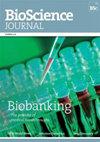Biometric assessment of early stem growth at a commercial stand of African mahogany (Khaya grandifoliola)
IF 0.6
4区 农林科学
Q3 AGRICULTURE, MULTIDISCIPLINARY
引用次数: 0
Abstract
African mahogany species (Khaya spp.) have proven to be promising in the Brazilian forestry scenario, replacing native mahogany owing to their medium-fast growth and relevant timber value. This study aimed to carry out forest inventory and assessments of a Khaya grandifoliola plantation in the first years after planting, test hypsometric models to describe tree growth, and identify the maximum commercial stem yield (i.e., greater than 6 m in height). The stand was located in the municipality of Piracanjuba (GO), where seedlings of seed origin were used. Twenty random plots with a 15 m radius were allocated, and the total height (HT), stem height (HS), diameter at breast height (DBH), crown area, and forest canopy were measured. Four hypsometric models were employed in this study. The best equation was selected based on determination coefficients and standard errors. Further, the models were cross-validated to evaluate predictability and bias. At four years of planting, the largest class of HS was found to range from 3.1 to 4.1 m, and most trees had a DBH ranging from 0.084 to 0.126 m. The percentage of trees with stems > 6 m was 8.35%. The linear model ensured more consistent results for estimating HT, while the quadratic and Weibull models led to more consistent results for HS. By using models, stem measurements can be measured based on DBH, ultimately aiding the selection of stem management strategies for the growth of forests with greater commercial value.非洲桃花心木(Khaya grandifoliola)商业林分早期树干生长的生物特征评估
非洲桃花心木物种(Khaya spp.)已被证明在巴西林业中很有前景,因为它们的生长速度中等且具有相关的木材价值,可以取代本地桃花心木。本研究旨在对Khaya grandifolila种植园在种植后的头几年进行森林清查和评估,测试描述树木生长的测量模型,并确定最大商业树干产量(即高度大于6米)。该林分位于皮拉坎朱巴市(GO),使用种子来源的幼苗。分配了20个半径为15m的随机地块,并测量了总高度(HT)、茎高(HS)、胸径(DBH)、树冠面积和林冠。本研究采用了四种高度测量模型。根据测定系数和标准误差选择最佳方程。此外,对模型进行了交叉验证,以评估可预测性和偏差。在种植四年时,发现最大的HS等级在3.1至4.1米之间,大多数树木的DBH在0.084至0.126米之间。树干>6米的树木的百分比为8.35%。线性模型确保了估计HT的结果更加一致,而二次和威布尔模型则使HS的结果更加稳定。通过使用模型,树干测量可以基于DBH进行测量,最终有助于为具有更大商业价值的森林生长选择树干管理策略。
本文章由计算机程序翻译,如有差异,请以英文原文为准。
求助全文
约1分钟内获得全文
求助全文
来源期刊

Bioscience Journal
Agricultural and Biological Sciences-General Agricultural and Biological Sciences
CiteScore
1.00
自引率
0.00%
发文量
90
审稿时长
48 weeks
期刊介绍:
The Bioscience Journal is an interdisciplinary electronic journal that publishes scientific articles in the areas of Agricultural Sciences, Biological Sciences and Health Sciences. Its mission is to disseminate new knowledge while contributing to the development of science in the country and in the world. The journal is published in a continuous flow, in English. The opinions and concepts expressed in the published articles are the sole responsibility of their authors.
 求助内容:
求助内容: 应助结果提醒方式:
应助结果提醒方式:


